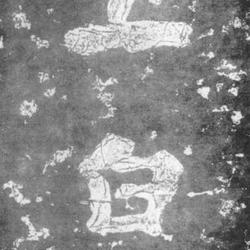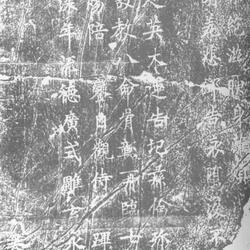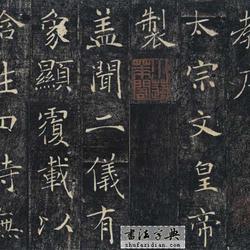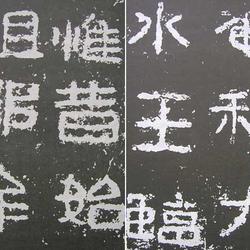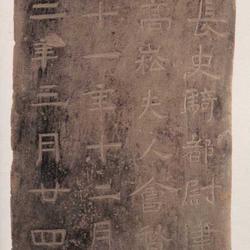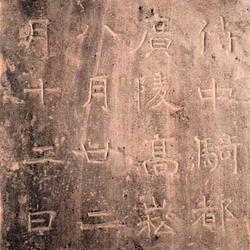In the main hall of Xueguanbao Douge Temple, about two to three kilometers west of the colorful sand forest in Luliang, Yunnan, stands an ancient stele. This is the "Cuan Longyan Stele", one of the famous "Er Cuan" in the country. Its full name is "The Monument of General Long Xiang of the Song Dynasty who protected the town of Barbarians, Wei Ning Prefecture Governor of Dengdu County, and envoy Hou Cuan of Dengdu County". This monument is the largest of the "two Cuans".
"Cuan Longyan Stele" is rectangular with a semicircular forehead, 3.38 meters high, 1.35 meters wide at the top, 1.46 meters wide at the bottom, and 0.25 meters thick. Compared with the "Cuan Baozi Monument", it is 1.55 meters higher, the average width exceeds 0.715 meters, and the thickness exceeds 0.04 meters. Calling it "Da Cuan" is worthy of its name. There are reliefs of green dragon, white tiger and red bird on the forehead of the stele. There is a hole (hole) in the middle of the lower part, with reliefs of the sun and moon on the left and right, a bird in the middle of the sun, and a toad in the middle of the moon. The Bei Yang Zhengshu contains 24 lines and a total of 904 words. The inscription on the stele is divided into three sections: the upper, middle and lower sections, with a total of 313 words, all of which are in the main text. The inscription narrates the origins of the Cuan family and traces the official history of the deceased's ancestors and grandchildren for three generations, indicating that the Cuan family was extremely powerful at that time and its relationship with the central government.
The stele was erected in the second year of Liu Song Dynasty (458) in the Southern Dynasty, 12 years after the death of Cuan Longyan, 53 years later than "Xiao Cuan", and it has a history of more than 1,500 years. The inscription was written by Cuan Daoqing.
This stele is recorded in "Yunnan Chronicles" written by Li Jing of the Yuan Dynasty, and also in "Yunnan General Chronicles" written in the Wanli Period of the Ming Dynasty. In the seventh year of Daoguang reign of the Qing Dynasty, Ruan Yuan, the governor of Yunnan and Guizhou and an epigrapher, visited Luliang Zhenyuan Fort, which is now Xueguan Fort. He ordered the prefect Zhang Hao to build a pavilion to protect it and wrote a postscript. This monument has become famous all over the world since then.
According to research, Cuan Longyan lived to be 61 years old. Compared with Cuan Baozi, he lived a very long life. Because of this, the stele is tall and the inscriptions are rich in content, providing extremely valuable historical materials for the study of the Cuan family that ruled Nanzhong for hundreds of years. The words in the inscription also proudly confirm the prosperity of the Cuan family from the side, reflecting the past prosperity of this fertile land in eastern Yunnan. This prosperity not only reflects the close relationship between the border areas and the central government, but also reflects the unity and integration of all ethnic groups in the border areas. This is precious information for us to study the history of the Yunnan nation, and it is also a valuable resource for us to study the "Cuan Township" that we are often proud of. "A rare treasure.
Like the "Cuan Baozi Stele", the calligraphy art of its inscriptions also has high artistic value. The calligraphy is strong and beautiful, and the structure is mainly square, but the turning brushwork has been used at the turning points, unlike "Cuan Baozi Stele". The rectangular folded corners of "Baozi Stele" have the characteristics of regular script. We can see from the roundness and strength of the strokes in "Cuan Longyan Stele" that the strokes are actually derived from seal script. Although the strokes are divided into square and round strokes, the strokes are all extremely thick. "Cuan Longyan Stele" is characterized by pitching and bowing, alternating density and sparseness in technique, and its structure is unique and relaxed. In "Guang Yi Zhou Shuang Yi", Kang Youwei praised it as "the first divine product" and "the first ancient and modern regular script", saying that "the lower part of the painting is like a Kun Dao carving jade, but the appearance is pure and beautiful; the layout is like a finely crafted painting" People have their own opinions, and they should be followed by Li Kaiji." In the "Postscript" written by Ruan Yuan, the governor of Yunnan and Guizhou during the Daoguang period of the Qing Dynasty to protect this stele, he said: "The text, style and calligraphy of this stele are all authentic works of the Han and Jin Dynasties, and I can't ask for more from the north. have to". "It is the first ancient stone in Yunnan". Looking at the whole stele, the calligraphy strokes are as powerful as being struck by a knife and an ax. It is an important document for studying the evolution of Chinese calligraphy from official to regular script.
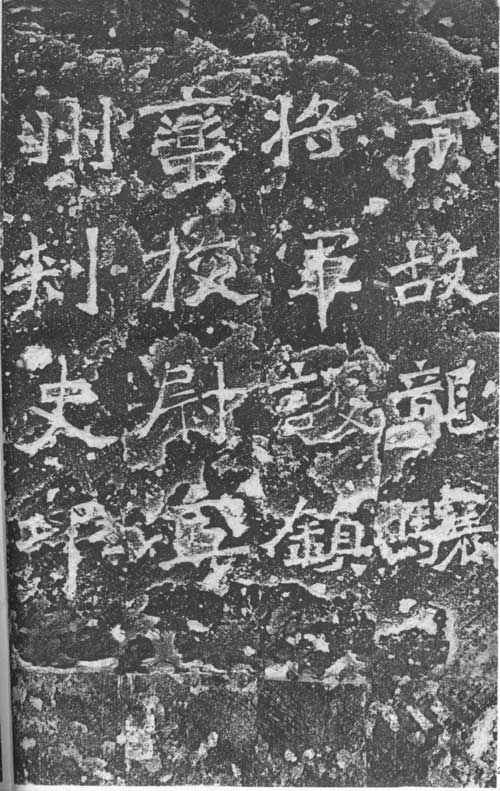
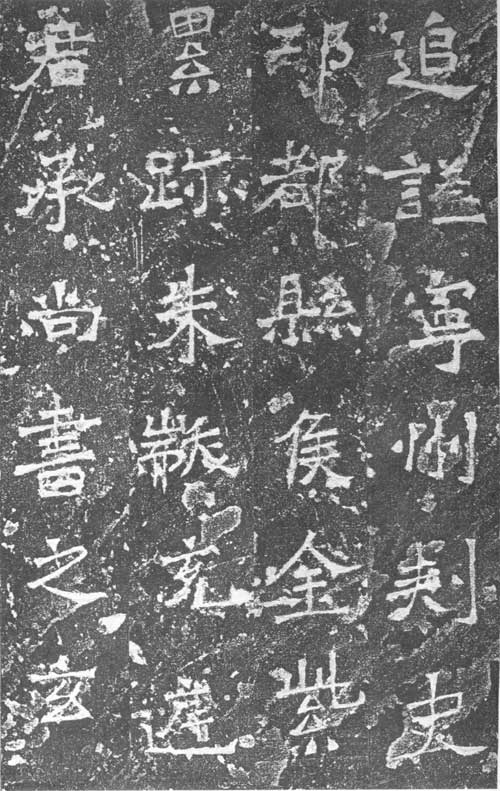
Explanation of Cuan Longyan Stele:
Monument of General Longxiang of the Song Dynasty who protected the commander of the barbarian army, Ningzhou Governor, Hou Cuan of Qiongdu County
Jun's taboo is Longyan, his courtesy name is Shide, and he is from Tongle County, Jianning. His predecessors were Shaohao Zhuanxu and Miaoyin. The clear source flows without stagnation, and the deep roots are solid without leaning. Summer (one line)
Later, when it was prosperous, the five teachings were laid down, the nine lands were honored, purified [consistent with thousands of years], and the benevolent merits were spread to thousands of sacrifices, so it was the glorious Huashan Mountain. Overlord Ying Chu, Zi Wen Zhi De in the Spring and Autumn Period, Ban Lang Shao Zong in (two lines)
Season leaves. If there is no luck in Yang Jiu, the cicada will slough off to the east of the river, and you will be free in the Central Plains. Ban Biao deleted the "Han Ji", and Ban Gu wrote the "Tao Xun". At the end of the Han Dynasty, Yuan Yan, the food was settled in Cuan, because of the clan. In-law concubines in the public clan, vibrating (three elements)
The tassel is like the royal family. Naizu Su, Wei Shangshu Pushe and Henan Yin, all have nine positions, Shu He moved to Shu in the middle dynasty, moved to Yong Shu, and flowed to the south. The tree was safe for nine generations, thousands of branches were flourishing, and thousands of leaves were flourishing; Xiang (four lines)
Wangbiao is based on the four surnames, and Miao Guan is prominent in Shangjing. Yinghao succeeds Xi, so he is beautiful. His ancestors were the prefect of Jinning and Jianning counties, General Long Xiang, and the governor of Ningzhou. Kaolongxiang, general of the auxiliary country, eight counties (five elements)
He was the prefect of Jianjun, Jinning and Jianning counties, and was posthumously named the governor of Ningzhou and the Marquis of Qiongdu County. There are traces of gold and purple, and red fur fills the courtyard. You are the great-great-grandson of Shangshu and the son of the commander of the army. Appearance Weiyu (six lines)
At that time, his chastity was better than that of his friends, and he was gentle and kind-hearted. You must hear it at home. The master of the rites and orders of this state is not in charge, and he is engaged in three separate projects. The history is officially in the dynasty, Jing Gong is on the right side, and benevolence is shown in the government and the public, (seven lines);
The famous fan of Qing Dynasty is in the distance. In the 10th year of Yixi's reign, the talented people were expelled from Liangzhong, Xiangyin was sent to Xizhu, and they moved to Nanman Mansion to join the Jin army. Dissecting Fu's own country, traveling in rich clothes during the day, singing folk songs (eight lines)
Scholars praised his virtue, so he passed through the Wuxiang Dynasty and became the chief minister of this state. But the king is generous and ambitious, and all the kingdoms return to the palace. Except for the scattered cavalry and servants, he has no embarrassment when he enters, and no sullen look when he retreats. He is loyal (Nine Lines)
Honesty and simplicity are in the heart of the emperor, and the fragrance is spread in Tianyi. In addition to General Longxiang and the prefect of Jinning, who were trying to defend Jinning, they rode chariots and axes, wore gold medals and purple ribbons, and held halberds and banners, and attacked and granted the title of Marquis of Qiongdu County. Years old in Renshen, one hundred (ten lines)
During the six-month period, the territory of the state was in turmoil, and the east and west borders were filled with ferocious wolves and robbers. You gathered an elite force of five thousand men, threw arrows and stones, defeated thousands of enemies, and cleared the border areas. Junnanzhong Rock, (11 lines) "
Favoring his favor, he moved his title to General Longxiang, Colonel Huzhaoman, Governor of Ningzhou, and Marquis of Qiongdu County. Jun's posture, Yingxiong's lofty strategy, Dun Chunyi's magnanimity, alone in the southern border, outstanding (twelve lines)
Although the son was born in Zheng, the bamboo strips are added to it. Therefore, he who has a smooth orchid voice and has a prosperous and handsome heir is not a gentleman like Kaiti. Who can do this? Haotian is not hanging, sleep is sick and the sleep is strong, the sixth year of prosperity (13 lines)
On the 11th, he died in early December of Bingxu. Li Shu mourned, Song Yi felt sad, and the Celestial Empire felt distant, so they gave him a posthumous gift from Zhonglao. Therefore, the official Jianning Zhao Cizhi, the eldest son Du of Bajun and others looked up to him (fourteen lines)
I am sorry for benevolence and will always admire Xuanze. I will dig up stone and tree monuments to praise Xiang Lie. Its hymn says: (fifteen lines)
The majestic Lingshan Mountain is so high and far away; or it is leaping in the sky, and the dragon is flying on the purple gate. Miao Miao is a prince, a noble person, a noble gentleman, and famous all over the world. Bundle silk and silk, betrothal and meet; travel to the south, grace (sixteen lines)
Zhanyun origin. Caressing and serving Fang Yue can overcome the residual and eliminate evil; after the leisurely Ming Dynasty, virtue is important and Tao is harmonious. Prepare seven scriptures, Qian Qian bandits bow, Feng Xiang Jingyi, Zeng Tengbi trace. How not to hang? Encountering this heavy frost, good trees (seventeen lines)
Destroyed withered, the light is hidden, admired in the three senses, filial friends are sad, inscribed on the mysterious stone, and the merits will be remembered for thousands of years. (Eighteen lines)
The ancestor has passed away, but his filial piety is still remembered, but his good wishes failed and he died early. His descendants, grandson Shuozi and other friends felt sad, looked up to the spiritual teachings, and admired his high position forever. Control is in March, mid-autumn in July, mountain climbing vegetables (line 19)
A mysterious stele was erected on the stone to represent the special merits of the present generation and to be remembered for thousands of generations. (Twenty lines)
Ning's eldest son, Dao Hong, died early, and his second brothers, Dao Shao, second brother Dao Xuan, and second brother Dao Chong, etc., built this monument. (line 21)
In the second year of Taiming, in Wuxu, in early September of Renzipu, his descendants Shuoduan, Shuoji, Shuoyou, Shuowan, Shuosi, Shuolu, Shuoluo, Shuoji and Shuosu were established. (Line 22)
Carpenter's Stele, Du Changzi, Yizhou; (line 23)
The text was written by Cuan Daoqing of Jianning. (Lines 24)
steel shade
Governor Shi Jianning Cuan Daowen
Sima Jianning Cuan Deyi
Recorded events: Liu Jin, Jinjun of Wuchang County; Meng Qinglun, the meritorious Cao Sanjun, built Ning; Cuanshuodeng, Cangcao Sanjun, built Ning; Zhou Xian, the Hucao Sanjun built Ning; Wang Lingwen, Yanmen County, Zhongbing Jinjun; the above Listed are Cao Jianning, Cuanyi, the chief bookkeeper of the former Duan Prefecture.
The middle section of the above column
Farewell to Jianning Cuan to respect the ancestors, Zhao Shifa in charge of Jinning in the middle, Jianning Cuan Derong in chief, Meng Shuming in Jianning, Yang Qiongzi in Xicao Yining, Lu Xiong in Xicao Jinning
The last part of the above list
Jian Ning Cuan Shi Ming, Sima Jian Ning Cuan Shun Jing, record of the events of the Jin army Jian Ning Mao Weizi Gong Cao San Jun Zhu Ti Li Rongzhi Cang Cao San Jun Zhen Ke Xie Guozi Hu Cao San Jun Nan Guang Yang Daoyu Zhong Bing San Jun Jian Ning Cuan Sun Ji
The front part of the above middle column
Manfu Gong Cao Jianning Li Yanzu Chief Secretary Jianning Meng Lingsun Chief Secretary Jianning Meng Shunde
The middle section of the above middle column
The subordinate Jianning Cuan was forced to record the affairs of Yiyang County Shu Zheng.
The last part of the middle column above
Recorder Meng Lin, Western Cao Liu Daoshan, Hu Cao Yin Zhongchang Jishi Zhang Shuao, Chaozhi Zhang Shibao, commander subordinate Wang Daoying □□ Yantou □□□ Wen □□ Kang
The preceding paragraphs above and below
The disciple Zhang Xun records things, Wan Jing, Xi Cao Yin Kai, Hu Cao Lai's uncle, saves troubles, Li Daoxue, Shu Zuo Shan Zhong, Qian Sheng Qingzi

